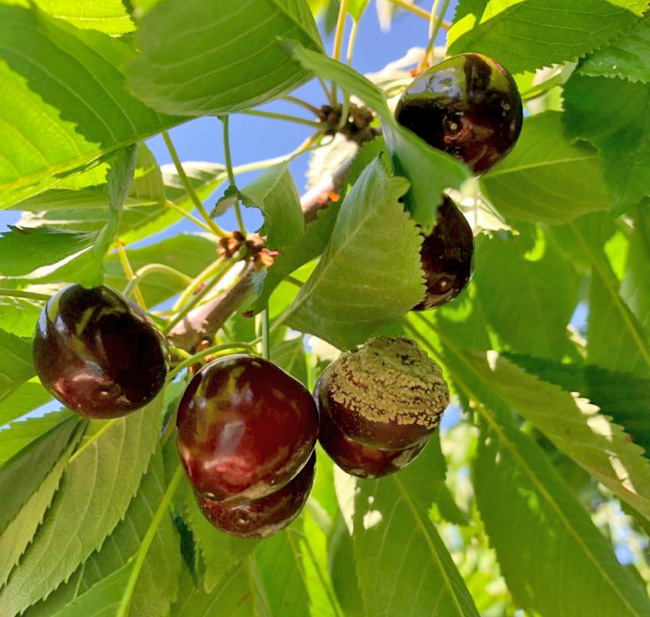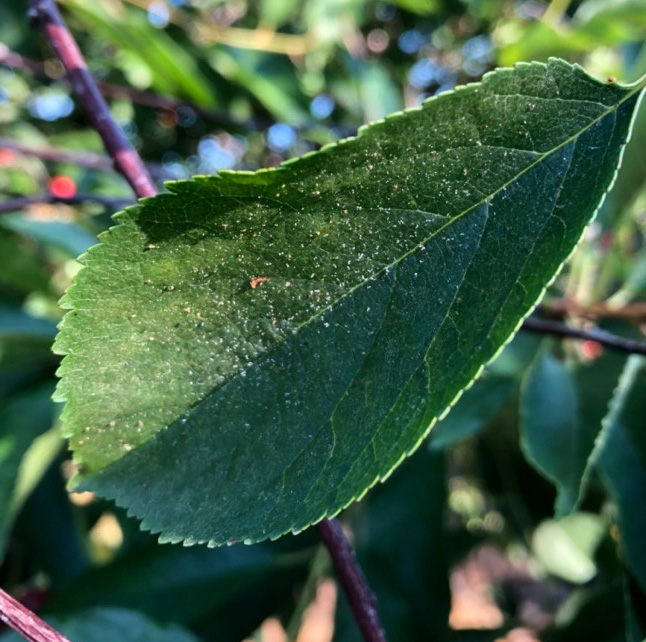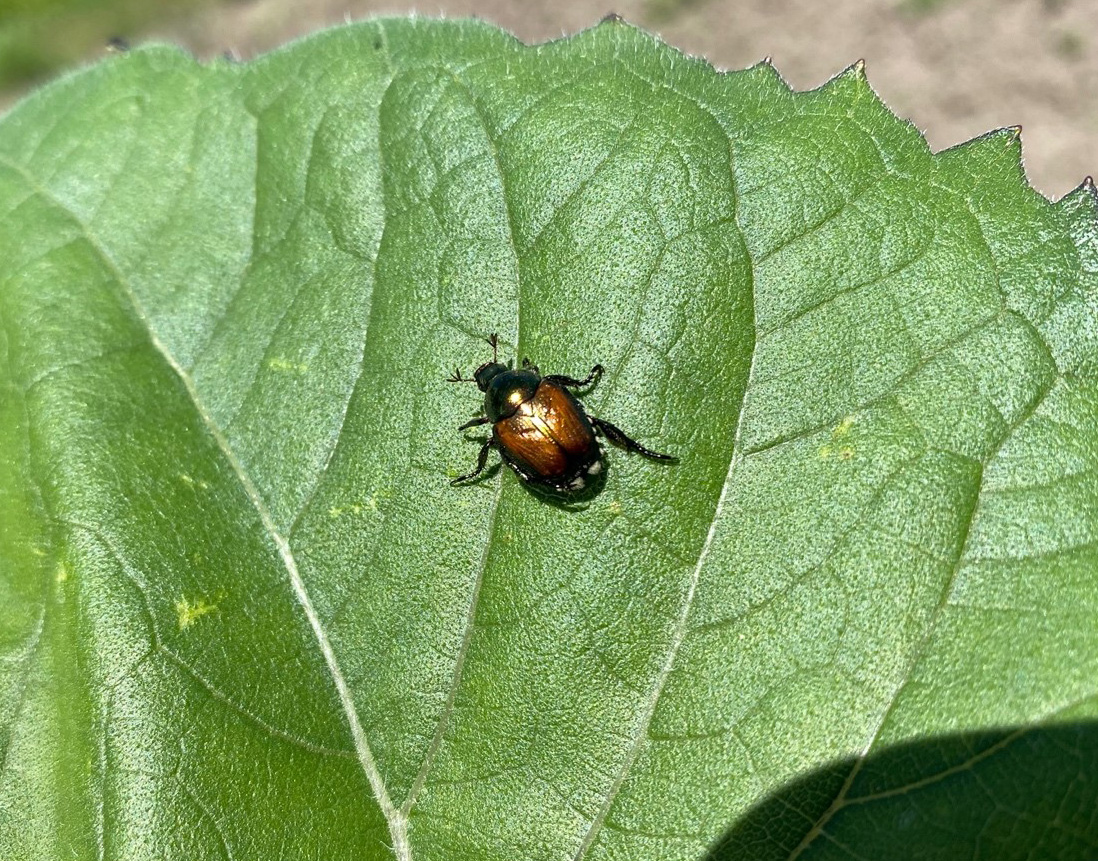Northwest Michigan fruit update – July 14, 2020
Cherry harvest has started in northwest Michigan, and fruit size is good following rain.

Weather report
The heat moved out over the weekend, and we had such a beautiful summer weekend without the extreme heat. Temperatures are predicted to rise again later this week, and some rain may be in the forecast. Wednesday into Thursday morning has the highest chance of rain. There are thunderstorms predicted for the Upper Peninsula for this afternoon, and rain is predicted to move into the northern part of the state tomorrow. Temperatures are expected to rise over the weekend into Monday, and we may see daytime highs in the mid 90s degrees Fahrenheit. The medium range forecast is predicted to be warmer than normal for the remainder of July and into the early part of August.
Although we started out cool this spring, the recent warm temperatures have brought our current seasonal totals close to normal and even slightly ahead of our 30-year averages. We are at 1642 growing degree days (GDD) base 42 and 1062 GDD base 50 compared to our 30-year averages of 1683 GDD base 42 and 1034 GDD base 50.
Review Jeff Andresen’s weather reports.
Crop report
The harvest season has arrived for some growers across the northwest. Some growers have started harvesting sweet cherries, and the stem-on harvest for brine cherries has been underway since last week. Some orchards that have a light crop are coming off quickly. Sweet cherries are uniformly ripening while some blocks of tart cherries still seem to have variability in fruit ripeness on the same tree. A few growers in warmer locations are shaking tart cherries this week. Growers have been cautious with ethephon use this season with the extreme heat, and many growers waited until the heat moved out before applying Ethrel. We have not heard of reports of damage from ethephon so far this season.
Pest report
Last week, we began finding spotted wing Drosophila (SWD) larvae in tart cherries at the Northwest Michigan Horticulture Research Center that have not been treated with insecticides. Yesterday, July 13, we also found larvae in untreated sweet cherries at the station. Rainfall late last week and recent cooler temperatures have been favorable for SWD oviposition; we have observed female flies laying eggs into unprotected fruit in the field over the past few days (Photo 1). Trap numbers continue to be low, but growers should not ease up on management programs as cherries are at high risk for SWD at this time (Table 1). The forecast is calling for cooler temperatures and possible rain. Many of the ‘excellent’ materials for SWD readily wash off in rain, and hence, recovering may be necessary if the predicted rains come. With the onset of cherry harvest, growers will need to be careful to meet pre-harvest intervals, retreatment intervals, maximum allowable amounts of active ingredients, etc. while also maintaining coverage to prevent SWD infested fruit at harvest. We remind growers that there are special labels for a reduced PHI of Mustang Maxx in both sweet and tart cherries this season; however, there is a seven-day retreatment interval restriction on this 24 C label. Please review and follow all label restrictions before making applications.
|
Traps (0=flies not present, 1=flies present) |
GDD 39.2⁰F from full bloom |
SWD risk |
|---|---|---|
|
0 |
GDD>1170 |
low |
|
1 |
954>GDD |
low |
|
1 |
954<GDD<1170 |
medium |
|
1 |
GDD>1170 |
high |
|
Table 1. Updated SWD Model for July 13, 2020 | ||||
|---|---|---|---|---|
|
Site |
Crop |
Bloom |
Current DD Base 39.2F from bloom to July 13 |
Forecast DD Base 39.2F from bloom to Jul 17 |
|
Benzonia |
Sweet cherry |
20-May-20 |
1478 |
1717 |
|
NWMHRC |
Sweet cherry |
22-May-20 |
1492 |
1635 |
|
Elk Rapids |
Sweet cherry |
22-May-20 |
1418 |
1555 |
|
Old Mission |
Sweet cherry |
22-May-20 |
1432 |
1574 |
|
Williamsburg |
Sweet cherry |
22-May-20 |
1451 |
1590 |
|
East Leland |
Sweet cherry |
23-May-20 |
1352 |
1494 |
|
Hart |
Tart cherry |
17-May-20 |
1615 |
1756 |
|
Benzonia |
Tart cherry |
24-May-20 |
1381 |
1519 |
|
East Leland |
Tart cherry |
25-May-20 |
1306 |
1448 |
|
Eastport |
Tart cherry |
25-May-20 |
1340 |
1484 |
|
Old Mission |
Tart cherry |
25-May-20 |
1362 |
1503 |
|
NWMHRC |
Tart cherry |
26-May-20 |
1388 |
1530 |
Rainfall last week provided adequate moisture for brown rot to continue to spread in sweet cherry varieties Sam and Ulster at the station (Photo 2). Last week, we found a few lingering and sporulating “June drops”; this week, it is not difficult to find clusters with brown rot infections. There was a high inoculum load in the block from heavy infections last season. There have been a few isolated reports of brown rot in commercial blocks, but for the most part, growers have kept this disease in check and fruit quality is good. It has been interesting to observe this disease progress as conditions have seemed on the drier side with the exception of a few heavy rains. Brown rot at the station and no or low brown rot incidence in commercial blocks indicates that growers’ management programs have been effective. Keep up the good work!

There was a low to high cherry leaf spot infection from July 9-11 depending on location. Symptoms from this event could begin showing up late this week into early next week. Cherry leaf spot has been a challenge in several orchards this season and growers have been diligent with programs to prevent further spread of the fungus. Powdery mildew is also progressing, and it is particularly noticeable on new tender leaves and shoots.
Two spotted spider mite populations continue to be high in both sweet and tart cherries and some growers may need to take action against these mites after harvest. At the station, webbing produced by two spotted spider mites is evident (Photo 3). The webbing contains all life stages of the mites as well as black specks of frass.

Obliquebanded leafroller flight is ongoing and eggs are hatching. We have been finding very small obliquebanded leafroller larvae in our fruit samples that we are monitoring for SWD larvae. Our observations at the station and reports from commercial blocks indicate that obliquebanded leafroller populations seem higher than usual this season.
San Jose scale crawler activity is winding down and the management window for crawlers has passed. Traps to begin monitoring for the second male flight should be deployed in the coming week.
Greater peach tree borer flight and lesser peach tree borers flight is ongoing with consistent trap catches of both borer pests. A few American plum borers were also trapped this week.
No cherry fruit flies have been detected.
In apples, we have been monitoring the sooty blotch and flyspeck model on Enviroweather. The model begins 10 days after petal fall and tracks the number of wet hours when wetting events are longer than four hours. When the model reaches 240 hours, symptoms from these diseases are estimated to be visible. To prevent the appearance of these diseases on fruit, management should be taken before the symptoms become visible (~200 hours of wetting as indicated by the model). The model is also customizable in that the user can input a date of application for a fungicide to reset the clock. Visit Enviroweather to read more about this model and how to use it.
Codling moth flight seems to be winding down with low numbers of moth catches this week. According to growing degree day accumulations since our biofix (June 1), egg hatch is ongoing, but the end is near. Nearly all (~99%) of eggs are estimated to have hatched at ~920 GDD base 50 after biofix which is estimated for this coming weekend.
European red mite populations are continuing to grow in apples and two spotted spider mites can also be found without difficulty. A few red mites were found on apple fruit this week; extensive feeding damage on the fruit by mites can cause russeting.
The second emergence of black stem borer is underway. At the station, young weak/stressed Gala trees (i.e. trees that were hit hard by fire blight last year) in a block adjacent to a woodlot have a few borer holes, and we have found the beetles emerging and boring new holes in the weak trees in this block.
As noted above, San Jose scale crawler activity is winding down and obliquebanded leafrollers larvae can also be found in apples at this time.
No apple maggots have been detected in our traps, but recent rain in southerly parts of the state stimulated emergence. Continue to monitor for emerging apple maggot flies as we are at the degree day timing for them to emerge.
Lastly, we have had a few isolated reports of Japanese beetle skeletonizing leaves in fruits, vegetables, and ornamentals (Photo 4). Japanese beetles are metallic green and brown in appearance, and they are related to rose chafers. Similar to rose chafers, Japanese beetle grubs live and mature in the ground where they feed on plant and turf roots. They emerge in the summer as an adult beetle that skeletonizes leaves when they feed. Japanese beetles also have an aggregation pheromone that attracts others of their species to hot spot locations where they can feed and mate. While these beetles are technically invasive to Michigan, they are not new. Japanese beetles are considered “established” in the state, although abundance in our region has been comparatively low to other regions in Michigan. In high populations, however, the beetles will feed on fruit.




 Print
Print Email
Email




